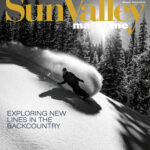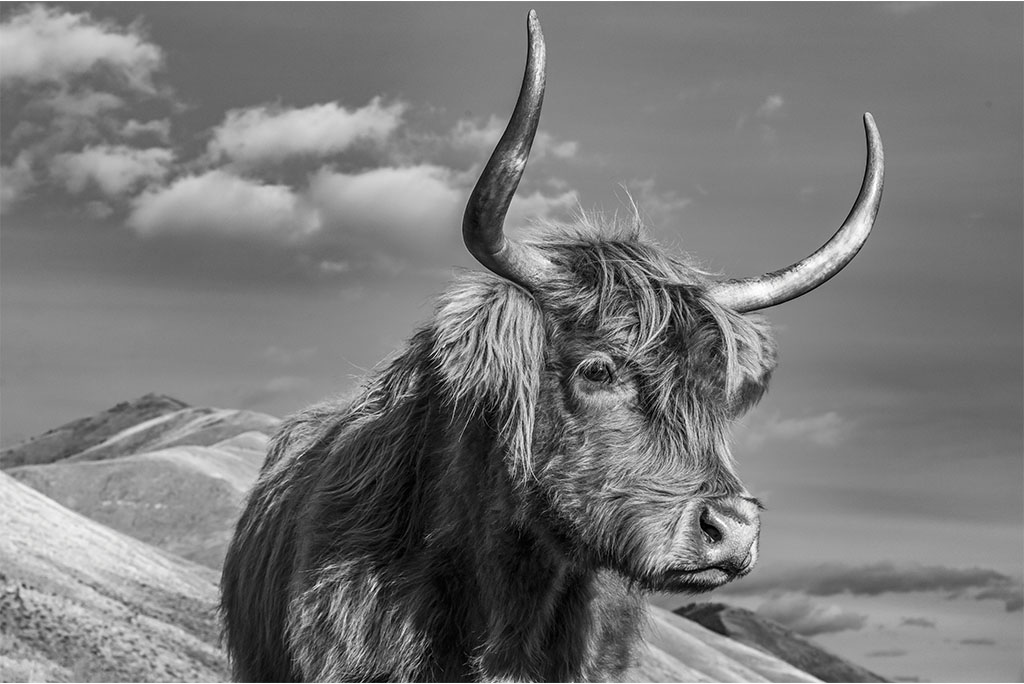It’s early summer in the Pioneer foothills, a remnant of snow and ice still clings to the high granite peaks. A fold of Highland cattle ambles through the lush grass and sagebrush on a leisurely trek to alpine meadows and misty draws, as easily suited to forage and thrive in the challenging conditions of Idaho’s mountains as in their Scottish Highlands origins. They are gorgeous beasts, serene and sauntering, strength and grace under tousled, long ginger red hair, in beautiful contrast to the blue sky and abundant foliage. These are the cattle of Hyndman Peak Beef & Cattle Co., a first generation regenerative-based ranching operation specializing in grass fed and finished Highland beef.
HPBC owners Jeff Brendel and Mia Cherp share a deep-rooted connection to the world of horses, cattle, and ranching though from different backgrounds early on in their lives. In the rugged terrain of the Wood River Valley, they have channeled their shared passion of the ranching lifestyle into raising Highland cattle and crafting exceptional beef, harvested humanely and sold direct to local consumers. Unique to the operation is that summer rangeland is just a short drive from Ketchum, enabling customers to visit and see firsthand where their meat comes from.
Beef ranching within a regenerative framework is a holistic grazing management and sustainable approach, prioritizing environmental health and emphasizing the well-being of the animals. Strategic rotational grazing patterns that mimic nature help prevent overgrazing, allowing for the regeneration of pastureland with the goal of isolating carbon and water in soils, thus increasing pasture productivity. Cattle who forage from land that is rich with micronutrients produce healthier, more sustainable beef, support local ecosystems and promote soil health.
“One of the reasons we chose to raise Highland cattle is because they are better suited for a grass-fed and finished environment,” explains Jeff. “Their meat is higher in protein and omega 3 fatty acids, leaner, and lower in cholesterol.” The Highland’s heavy coat, which is a double layer hide, insulates against harsh climates and keeps them plenty warm in the winter months, allowing them to thrive without the need for developing excess fat to stay warm. Highlands grow their fat inside of the muscle tissue which means less fat is produced, providing a richer, more flavorful taste profile. Lower fat production also creates an excellent marbling quality and ensures there will be more usable meat per pound of body weight. Recent studies in both North America and the UK have shown that Highland Beef is consistently much lower in fat content and cholesterol than other breeds.
Highlands tend to be self-sufficient, and it’s easy to let them be and enjoy their environment. Rarely do Jeff and Mia need to intervene in the cattle’s day-to-day aside from rotating them to different pastures to provide diverse forage, clean water sources, and natural living conditions. The fold is moved around daily, or every other day, using electrical fencing to create small paddocks, which confines the cows to an area for more intense grazing. (The cattle winter in the Carey area where they are fed locally sourced grass and hay).
On their rounds in the early summer, Jeff and Mia often come upon babies born overnight. Highland cows are noted for being highly devoted and protective mothers, and on average, are noted for requiring little assistance when calving. They often breed beyond the age of eighteen and can raise fifteen or more calves in their lifetime. Females conceive quickly, calve easily, and breed back—a beneficial result of native foraging.
The synergism between these creatures and their human caretakers is quite extraordinary, and it is a wonder to see in person. “We care for them the best we possibly can, to ensure they are living their best lives,” Mia says. “They’re very much a part of our family and our existence. We respect and honor them throughout their entire life span, harvest, and beyond.”
HPBC takes a “nose-to-tail” approach to harvest, utilizing as much of the animal as possible. “Aside from ground beef packages and seasonal specialty boxes, we only sell beef shares with free delivery to Blaine County residents,” Mia says. “Hides and skulls are sent to local makers and artisans. Bones are used by those looking to make their own soup stocks and even organs are used in our special ground beef organ blend.”
As consumers deliberate the general morality of consuming meat, Hyndman Peak Cattle Co. is firmly established on the foundation of holistic-based ranching – animals that sustain us should have quality lives and their care is intertwined in that. “Purchasing local beef not only supports the local economy but is an investment in a better product with quality being prioritized over everything else,” Jeff says.
- The Highland is a Scottish breed of rustic cattle, the oldest registered breed of cattle in the world. Their presence was first recorded in the Outer Hebrides in the 6th Today, they can be found in the USA, Canada, Europe, and Australia.
- Although the classic image of a Highland cow today is red, they also come in other shades including yellow, brindle, dun, white, and black, the breed’s original color.
- All Highland cattle have horns. They use them to knock down brush to graze on, scratch away snow for foraging, and protection from predators. Horns on females are generally upswept and of a finer texture. Male horns are more forward pointing and massive.
- The collective name for a group of Highland cattle is a fold. The word ‘fold’ dates to the olden days in Scotland when Highland cattle were brought into an open stone shelter at night called a fold. This protected them from the weather and wolves.
- Highland cattle love to make friends with each other, showing their affection by licking and play-fighting with each other. Within a herd they have a great understanding of their own social hierarchy and never fight. Highland cows love humans and enjoy their attention, often seeking affection from approaching walkers. The only time it is generally not regarded as a good idea to approach the Highland Cow, is when she is with her calf. But it is not only the mothers that take good care of their calves and will protect them from predators, the entire herd will prioritize and protect the calves.
FAT CONTENT
Highland Beef Overall 4.5 g/100g
Other Commercial Breeds Beef Overall 15.6 g/100g
CHOLESTEROL CONTENT
Highland Beef Overall 40.9 mg/100g
Other Commercial Breeds Beef Overall 64.3 mg/100g
PROTEIN
Highland Beef Overall 20.7 g/100g
Other Commercial Breeds Beef Overall 18.6 g/100g
IRON
Highland Beef Overall 2.1 mg/100g
Other Commercial Breeds Beef Overall 2.0/100g
Source: Scottish Agricultural College, Dept. of Food Science and Technology
published by McCance & Widdowson, Ministry of Agriculture, Fisheries and Food.
___________________________
To sample the flavorful Highland Beef, Lefty’s in Ketchum offers their burger as a Thursday only special. Shares can be preordered on the website providing the opportunity for a customized cut sheet. Animals are harvested throughout the year, assuring a fresh supply of meat.


